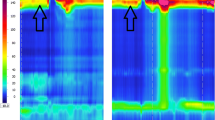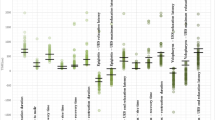Abstract
Little is known about the effect of achalasia and gastroesophageal reflux disease (GERD) on compliance of the esophageal body and the lower esophageal sphincter (LES). Twenty-two patients with achalasia, 14 with GERD, and 14 asymptomatic volunteers were assessed. Recording apparatus consisted of a specially developed PVC bag tied to a compliance catheter, a barostat, and a polygraph. Intrabag pressures were increased incrementally while the bag volume was recorded. In each subject, pressure–volume graphs were constructed for both the esophageal body and LES and the compliance calculated. In achalasia, compliance of the esophageal body was significantly higher (P < 0.01) than in controls, whereas LES compliance was similar. Patients with GERD had a highly compliant LES in comparison to both controls and to patients with achalasia (P < 0.01 and P < 0.001, respectively); however there was no difference in their esophageal body compliance. In conclusion, foregut motility disorders can cause changes in organ compliance that are detectable using a barostat and a suitably designed compliance bag. Further measurement of compliance may provide clues to the pathogenesis of these disorders.
Similar content being viewed by others
REFERENCES
Paul RJ: Smooth muscle: Mechanochemical energy conversion relations between metabolism and contractility. In Physiology of the Gastrointestinal Tract. LR Johnson (ed). New York, Raven Press, 1981, pp 269–279
Barlow JD, Buckton GK: Static manometry: procedures and analysis. In Clinical Measurement in Gastroenterology. DF Evans, GK Buckton (eds). Blackwell Science Ltd, Oxford, UK, 1997, pp 35–79
Azpiroz F, Malagelada JR: Physiological variations in canine gastric tone measured by an electronic barostat. Am J Physiol 248:G229–G237, 1985
Mayrand S, Diamant E: Measurement of human esophageal tone in vivo. Gastroenterology 105:1411–1420, 1993
Gonzalez M, Mearin F, Vasconez C, Armengol JR, Malagelada JR: Oesophageal tone in patients with achalasia. Gut 41:291–296, 1997
Paterson WG, Selucky M, Hynna-Liepert TT: Effect of intraesophageal location and muscarinic blockade on balloon distension-induced chest pain. Dig Dis Sci 36:282–288, 1991
Smout AJ, DeVore MS, Dalton CB, Castell DO: Effect of nifedipine on esophageal tone and perception of esophageal distension. Dig Dis Sci 37:598–602, 1992
Gregerson H, Giversen IM, Rasmussen LM, Tottrup A: Biomechanical wall properties and collagen content in the partially obstructed opossum esophagus. Gastroenterology 103:1547–1551, 1992
Holland CT, Satchell PM, Farrow BR: Oesophageal compliance in the naturally occurring canine megaoesophagus. Aust Vet J 70:414–420, 1993
Mearin F, Vasconez C, Zárate N, Malagelada JR: Esophageal tone in patients with total aperistalsis: gastroesophageal reflux disease versus achalasia. Am J Physiol Gastrointest Liver Physiol 279:G374–G379, 2000
Mearin F, Malagelada JR: Complete lower esophageal sphincter relaxation observed in some achalasia patients is functionally inadequate. Am J Physiol Gastrointest Liver Physiol 278:G376–G383, 2000
Mearin F, Fonollosa V, Vilardell M, Malagelada JR: Mechanical properties of the gastro-esophageal junction in health, achalasia, and scleroderma. Scand J Gastroenterol 35:705–710, 2000
Demeester TR, Johnson LF, Joseph GJ, Toscano MS, Hall AW, Skinner DB: Patterns of gastroesophageal reflux in health and disease. Ann Surg 184:459–470, 1976
Whitehead WE, Delvaux M: Standardisation of barostat procedures for testing smooth muscle tone and sensory thresholds in the gastrointestinal tract. The Working Team of Glaxo-Wellcome Research, UK. Dig Dis Sci 42:223–241, 1997
Biancani P, Goyal RK, Phillips A, Spiro HM: Mechanics of sphincter action. Studies on the lower esophageal sphincter. J Clin Invest 52:2973–2978, 1973
Mayrand S, Tremblay L, Diamant N: In vivo measurement of feline esophageal tone. Am J Physiol 267:G914–G921, 1994
Bonavina L, Evander A, DeMeester TR, Walther B, Cheng SC, Palazzo L, Concannon JL: Length of the distal esophageal sphincter and competency of the cardia. Am J Surg 151:25–34, 1986
Goldblum JR, Whyte RI, Orringer MB, Appelman HD: Achalasia. A morphologic study of 42 resected specimens. Am J Surg Pathol 18:327–337, 1994
Author information
Authors and Affiliations
Rights and permissions
About this article
Cite this article
Jenkinson, A.D., Scott, S.M., Yazaki, E. et al. Compliance Measurement of Lower Esophageal Sphincter and Esophageal Body in Achalasia and Gastroesophageal Reflux Disease. Dig Dis Sci 46, 1937–1942 (2001). https://doi.org/10.1023/A:1010639232137
Issue Date:
DOI: https://doi.org/10.1023/A:1010639232137




